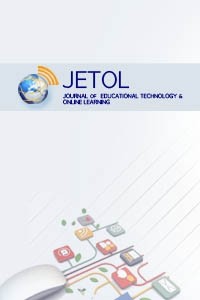Teaching writing skills in EFL classes with blending learning
Teaching writing skills in EFL classes with blending learning
blended learning, writing skills K-12, COVID-19,
___
- Adas, D & Bakir, A. (2013). Writing difficulties and new solutions: Blended learning as an approach to improve writing abilities. International Journal of Humanities and Social Science, 3(9), 254-266.
- Akkoyunlu, B., Soylu, M. (2006). A study on students’ views on blended learning environment., Turkish Online Journal of Distance Education,7(3).
- Alijani, G. S., Kwun, O., & Yu, Y. (2014). Effectiveness of blended learning in KIPP New Orleans’ schools. Academy of Educational Leadership Journal, 18(2), 125-141.
- AlKhaleel, A. (2019). The advantages of using blended learning in studying English as a foreign language at the University of Tabuk. Modern Journal of Language Teaching Methods, 9(2),1-7.
- Anh, D. T. N. (2019). EFL student’s writing skills: Challenges and remedies. IOSR Journal of Research & Method in Education, 9(6), 74-84.
- Anthony, B., Kamaludin, A., Romli, A., Raffei, A. F. M., Abdullah, A., Ming, G. L., et al. (2019). Exploring the role of blended learning for teaching and learning effectiveness in institutions of higher learning: An empirical investigation. Education and Information Technologies, 24(6), 3433–3466.
- Barrot, J. S. (2016) Using Facebook-based e-portfolio in ESL writing classrooms: impact and challenges. Language, culture and curriculum, 29(3), 286-301.
- Boelens, Voet, R, Wever, B. (2018). The design of blended learning in response to student diversity in higher education: Instructors’ views and use of differentiated instruction in blended learning. Computers & Education, 120 (2018), 197-212, doi:10.1016/j.compedu.2018.02.009.
- Bonk, C. J. & Graham, C. R. (Eds.). (2009). Handbook of blended learning: Global perspectives, local designs. Pfeiffer Publishing.
- Bowyer, J. (2017). Evaluating blended learning: Bringing the elements Together. Retrieved from http://www.cambridgeassessment.org.uk/Images/375446-evaluating-blendedlearning-bringing-the-elements-together.pdf.
- Brysch, C. P. (2020) Teacher Attitudes toward Alternative Professional Development in Geography, Journal of Geography, 119:2, 55-62, DOI: 10.1080/00221341.2019.1706621.
- Charoenwet, S., & Christensen, A. (2016). The effect of Edmodo learning network on students’ perception, self- regulated learning behaviours and learning performance. Proceedings of the 10th International Multi- Conference on Society, Cybernetics, and Informatics, 297-300.
- Creswell, J., & Plano Clark, V. (2011). Designing and conducting mixed methods research. Thousand Oaks: Sage Publications.
- Educause Horizon Report (2019). Hybrid Learning. from https://library.educause.edu/topics/teaching-and-learning/blended-learning#?page=1&sortBy=relevance&sortOrder=asc.
- Educause Horizon Report (2021). Educause Horizon Report Teaching and Learning Edition. https://library.educause.edu//media/files/library/2021/4/2021hrteachinglearning.pdf?#page=4&la=en&hash=64CACBDA4DAC0F6158951941AD2A8952A9A81100.
- Graham, C. R. (2019). Current research in blended learning. In M. G. Moore & W. C. Diehl (Eds.), Handbook of distance education, 173–188.Routledge
- Graham, C. R. and Robison, R. (2007). Realizing the transformational potential of blended learning: Comparing cases of transforming blends and enhancing blends in higher education. In blended learning: Research perspectives, (Eds) Picciano, A. G. and Dziuban, C. D. 83–110. Needham, MA: Sloan Consortium.
- Graham, C. R. and Allen, S. (2009). Designing blended learning environments. IGI Global.
- INACOL. (2011). The online learning definitions project. Retrieved from http://www.inacol.org/wp-content/uploads/2015/02/iNACOL_DefinitionsProject.pdf.
- Horn, M. B., Staker, H. (2014). Blended: Using disruptive innovation to improve schools: Jossey-Bass.
- Lamb, J. (2001). Blended learning is the new buzz phase. FT.com.
- NACOL. (2008). Fast Facts About Online Learning, 1-6. Vienna: North American Council for Online Learning. Retrieved February 28, 2019, from http://www.NACOL.org.
- Nunan, D. (1998). Language Teaching Methodology a textbook for teachers. Redwood books: UK.
- Oliver, K., Kellogg, S.(2015).Credit Recovery in a Virtual School: Affordances of Online Learning for the At-Risk Student. Journal of Online Learning Research, 1(2), 191-218. https://files.eric.ed.gov/fulltext/EJ1148607.pdf.
- Olshtain, E. (2001). Functional task for mastering the mechanics of writing and going just beyond. In M. CelceMurcia (Eds.) Teaching English as a second or foreign language (pp.207-217).UK: Heinle & Heinle.
- Purnawarman, P., Susilawati, S., & Sundayana, W. (2016). The use of Edmodo in teaching writing in a blended learning setting. Indonesian Journal of Applied Linguistics, 5(2), 242-252.
- Puspita N. & Hasyim, U.A. (2019). Implementing Blended Learning to Promote Sustainable Teaching and Learning Process in Writing Class. Retrieved from http://ejournal.radenintan.ac.id/index.php/ENGEDU/article/view/4427.
- Shih, R.C. (2011). Can Web 2.0 technology assist college students in learning English writing? Integrating Facebook and peer assessment with blended learning. Australasian Journal of Educational Technology, 27(5), 829-845.
- Singh, H.ve Reed, C. (2001). A White Paper: Achieving Success with Blended Learning. Centra Software.
- Wang, N., Chen, J., Tai, M., & Zhang, J. (2019). Blended learning for Chinese university EFL learners: Learning environment and learner perceptions. Computer Assisted Language Learning, 1–27, doi:10.1080/09588221.2019.1607881.
- ISSN: 2618-6586
- Yayın Aralığı: Yılda 3 Sayı
- Başlangıç: 2017
- Yayıncı: Gürhan DURAK
Investigating learner motivation in online education in terms of self-efficacy and self-regulation
Psycho-social and Educational Dimension of the COVID-19 Lockdown for Elementary School Students
Teaching writing skills in EFL classes with blending learning
Murat ATAİZİ, İstek AKSAK KÖMÜR
Umit IZGI-ONBASILI, Burcu SEZGİNSOY
Assuring quality in online learning
A systematic review of educational suggestions on generation Z in the context of distance education
